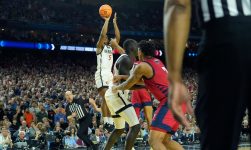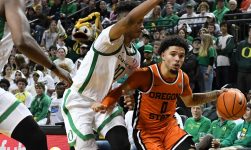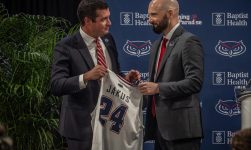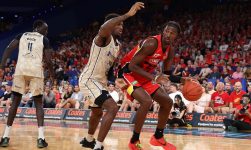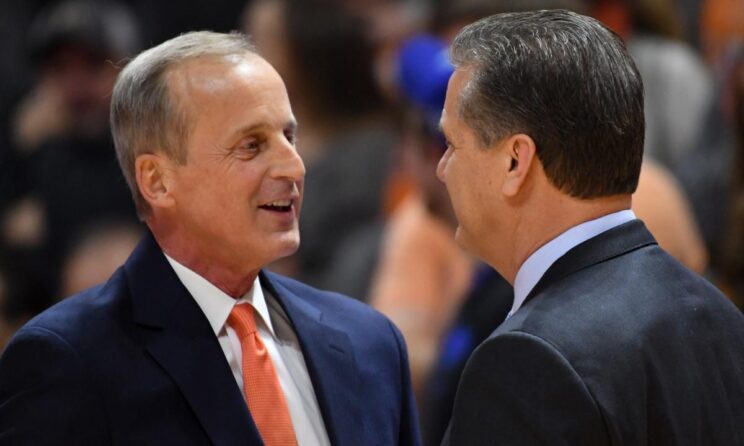
Mike Tranghese used to warn his Big East presidents and athletic directors about evaluating men’s basketball success.
Don’t gauge success by national championship banners, or you’ll set yourself up for disappointment.
“Besides being good, you have to be lucky. You’ve got to get through six games,” Tranghese, the former Big East commissioner, told USA TODAY Sports. “Six games. That’s hard. Really hard.”
Tranghese worked for the Big East since its 1979 launch, and he’d serve 19 years as commissioner, beginning in 1990.
We’re talking O.G. Big East, the conference that spawned Cinderella with 1985 Villanova, a star-studded league from Patrick Ewing and Chris Mullen through Allen Iverson and Rip Hamilton to Carmelo Anthony and Emeka Okafor.
A hoops dynamo … which went from ’85 until ’99 without producing a national champion.
“Are you going to tell me we didn’t have good teams? We had very good teams,” said Tranghese, now in his seventh year as the Southeastern Conference’s special adviser for men’s basketball.
“It’s just that it’s hard.”
So, Tranghese isn’t alarmed by the SEC’s men’s basketball championship drought, despite an enhanced commitment to the sport. Kentucky, in 2012, was the last SEC team to win it all.
SEC schools supplied five of the nation’s top 12 men’s basketball coaching salaries when this season began, in USA TODAY’s latest analysis. The salary list features a facelift this year after well-paid stalwarts Mike Krzyzewski and Jay Wright retired.
FROM $63K TO HIGHEST PAID: We tracked John Calipari’s pay over his 31-year career. Here’s how he became nation’s top-paid Division I men’s basketball coach
FOLLOW THE MONEY: Explore our searchable database for men’s college basketball coaches
SEC basketball is on solid footing. The conference may tie its record with eight NCAA selections.
“I think we’re poised to have a team ascend to the top of the competitive mountain this year – and, if not this year, soon,” SEC Commissioner Greg Sankey told USA TODAY Sports.
Story continues
In the past 10 tournaments, the SEC supplied six Final Four teams. That matches the Big 12 and Big East and ranks one shy of the ACC and Big Ten.
But, investment doesn’t ensure championships in a tournament celebrated for its madness.
Why SEC re-evaluated men’s basketball after 2016
Sankey’s conference rules football and swings a mighty sword in other sports.
But three times from 2013-16, the SEC qualified just three men’s basketball teams for the NCAA tournament. Twice, it trailed the Atlantic-10 and the American Athletic Conference in NCAA bids during that period.
The SEC re-evaluated its approach in 2016 after qualifying three teams for the tournament, with none advancing beyond the Sweet 16.
“We weren’t meeting our expectations for competitive achievement,” said Sankey, the SEC’s commissioner since 2015. “And you look at baseball, softball, gymnastics, women’s basketball, women’s volleyball, soccer, we didn’t have any sports that had only three teams in the postseason.”
The SEC attacked the problem on multiple fronts. Importantly, it beefed up nonconference scheduling, and more schools committed to hiring (and investing in retaining) better coaches.
“There is a price for success,” Arkansas athletic director Hunter Yurachek told USA TODAY Sports last year.
To Yurachek’s point, coach Eric Musselman took the Razorbacks to the Elite Eight in consecutive seasons. His $4.1 million salary put him among the top 12 nationally entering the season. Other SEC coaches with that distinction are Kentucky’s John Calipari ($8.5 million), Tennessee’s Rick Barnes ($5.45 million), Auburn’s Bruce Pearl ($5.45 million) and Texas A&M’s Buzz Williams ($4.1 million). After a contract extension this winter, Alabama’s Nate Oats ($4.5 million) became the SEC’s sixth coach whose annualized pay rate exceeds $4 million.
All six coach teams projected to make the NCAA tournament. Oats’ Crimson Tide is a possible No. 1 seed.
Tennessee coach Rick Barnes, left, and Kentucky coach John Calipari. Randy Sartin, USA TODAY Sports
National titles remain elusive.
Arkansas, under Nolan Richardson, won the national championship in 1994 and finished as runner-up in ’95. Since then, just two SEC schools have reached the NCAA finals: Kentucky and Florida.
Top-dollar coaches afford no guarantee of championship success in a single-elimination, upset-filled tournament affected by draw, injuries, officiating and luck.
So, why bother with the investment?
“It’s not a total crapshoot,” Tranghese said. “You’re not winning if you’re a lousy coach, and you’re not winning if you have lousy players.”
As Sankey pointed out, teams rarely go from underdog to national champion.
Twelve of the past 15 national champions were a No. 1 seed.
A good coach, with a good team, remains a good model.
Is SEC’s men’s basketball solved? It’s a deeper conference, anyway
Tranghese suggests evaluating a conference’s basketball success by its number of NCAA bids and whether those teams won games after selection.
By that measuring stick, the SEC is enjoying a competitive run. The SEC averaged 6.4 bids throughout the past five tournaments. That matches the 10-team Big 12’s output and trails only the ACC and Big Ten.
The SEC is fourth in total tournament wins during that five-year stretch and fourth in tournament winning percentage.
In sum: The SEC has, on average, been the nation’s fourth-best men’s basketball conference since 2017, trailing the ACC, Big 12 and Big Ten.
And what of the missing piece, a national championship?
“Time will take care of that,” said Jeremy Foley, Florida’s former longtime athletic director.
Foley knows more than most about hanging banners after he made the best SEC men’s basketball hire of the past 30 years.
How the SEC has fared since Billy Donovan
In 1996, Foley hired Billy Donovan, a 30-year-old Rick Pitino disciple, to a salary of $375,000.
Foley liked Donovan’s two years of head coaching experience at Marshall, and Donovan nailed his interview.
“His enthusiasm, his passion just rocketed out of the chair,” Foley recalled to USA TODAY Sports. “I was just blown away by his knowledge of the game, his ability to communicate.”
Florida had reached the Final Four under Lon Kruger but lacked a rich basketball history. Foley wanted to change that, although he didn’t issue Final Four demands.
“We just need to be one of the 64,” Foley remembers telling Donovan.
Donovan exceeded that. Florida’s court now bears his name after his Gators won national championships in 2006 and ’07. They remain the last team to win consecutive titles.
This marks the 15th NCAA tournament since Donovan’s last championship. Since then, the ACC has produced five titles, the Big East four and the Big 12 three. The SEC and AAC have one apiece.
Another SEC school that hired from a midmajor is best positioned to end the drought this year. Alabama plucked Oats from Buffalo. In Oats’ fourth season, Alabama is talented enough to make its first Final Four in program history.
A top-dollar coach makes NCAA tournament qualification a safer bet
The Big Ten’s national title drought dwarfs the SEC’s. Michigan State’s 2000 championship is the most recent for a conference that boasts a strong basketball reputation and is no salary cheapskate.
If a top-priced coach offers no guarantee of championship banners, what does the investment supply?
Usually, an invite to the annual bash.
Top earners Calipari, Tom Izzo, Bill Self and Barnes have combined for 94 NCAA tournament appearances, a number that will grow to 98 this month. Thirteen of the 14 schools that were paying their coach at least $4 million entering this season have teams projected to earn NCAA selection.
“A coach’s leadership relates to an entire year. It relates to what happens year after year after year, and achieving a national championship is an incredibly difficult challenge,” Sankey said. “We’ve not achieved the pinnacle in men’s basketball, but I would not reduce an evaluation of a coach’s effectiveness simply to that moment.”
Sankey said he expects the SEC to supply at least one Final Four team each year, a goal last achieved by Auburn in 2019.
Investment does not eliminate the upsets of March.
Syracuse’s Jim Boeheim is the only active coach with more NCAA tournament victories than Calipari’s 56, but Calipari’s last Final Four came in 2015. His Wildcats lost as a No. 2 seed in the first round last year.
Barnes parlayed a 2019 overture from UCLA into a richer deal with the Vols. Tennessee will make its fifth straight tournament appearance. He’s never taken the Vols beyond the Sweet 16, though. Barnes’ last Elite Eight came 15 years ago, at Texas. He’s 25-26 overall in the NCAA tournament.
Still, Barnes has outperformed either of Tennessee’s two previous coaches. Outdoing your predecessor is a persistent trait among top earners.
Pearl took Auburn to its first Final Four in his fifth season.
Musselman is Arkansas’ best coach since Richardson.
The Aggies’ 15 conference victories this season under Williams are a program record.
So, what does a school receive for men’s basketball investment? A spot in the Big Dance, a shot at a deep run, but no guarantee.
“That,” Tranghese said, “is what’s great about the tournament. It is hard to win.”
Blake Toppmeyer is an SEC Columnist for the USA TODAY Network. Email him at [email protected] and follow him on Twitter @btoppmeyer.
This article originally appeared on USA TODAY NETWORK: SEC men’s hoops coaching salaries don’t guarantee NCAA tournament wins

